Insurance & Negligence: Adelaide Uni Commercial Law Case Analysis
VerifiedAdded on 2023/06/12
|10
|2557
|398
Case Study
AI Summary
This assignment presents a detailed legal case study concerning Adelaide Show Ltd's insurance claim following an accident and Peter's personal injury claim against Amusement Rides Pty Ltd. The first issue examines whether All Business Insurance Pty Ltd can reject Adelaide Show's claim based on an exclusion clause related to negligence and acts of trespassers, analyzing the applicability of Section 54 of the Insurance Contracts Act 1984 (Cth) and relevant case law like Antico v Heath Fielding Australia Pty Ltd and Maxwell v Highway Hauliers Pty Ltd. The second issue focuses on Peter's claim, evaluating the validity and applicability of an exclusion clause on his ticket, the principle of volenti non fit iniuria, and the doctrine of remoteness of damage, referencing cases like Thompson v LMS Railway, McCutcheon v MacBrayne, and The Wagon Mound no 1 to determine if Amusement Rides Pty Ltd is liable for Peter's injuries due to a latent manufacturing defect.
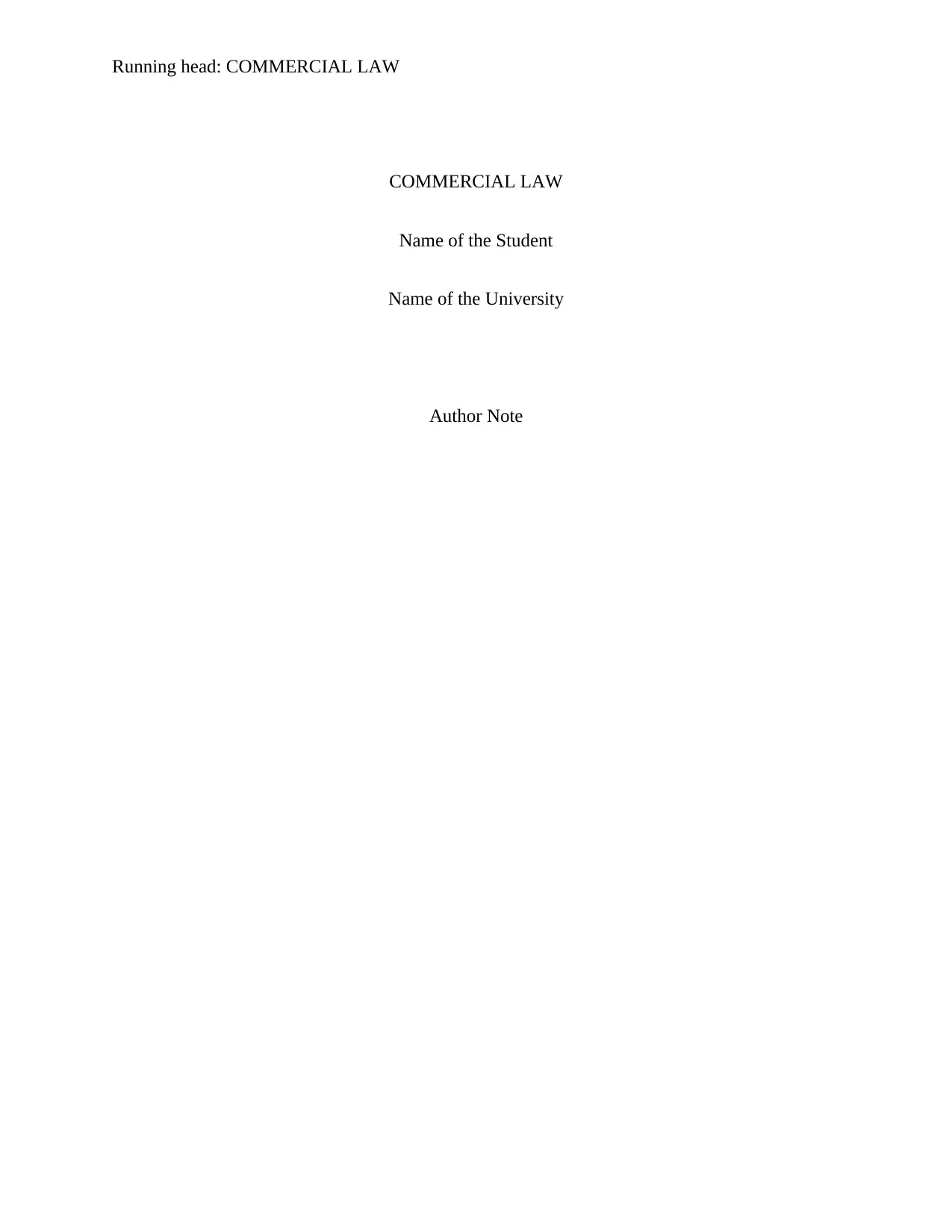
Running head: COMMERCIAL LAW
COMMERCIAL LAW
Name of the Student
Name of the University
Author Note
COMMERCIAL LAW
Name of the Student
Name of the University
Author Note
Paraphrase This Document
Need a fresh take? Get an instant paraphrase of this document with our AI Paraphraser
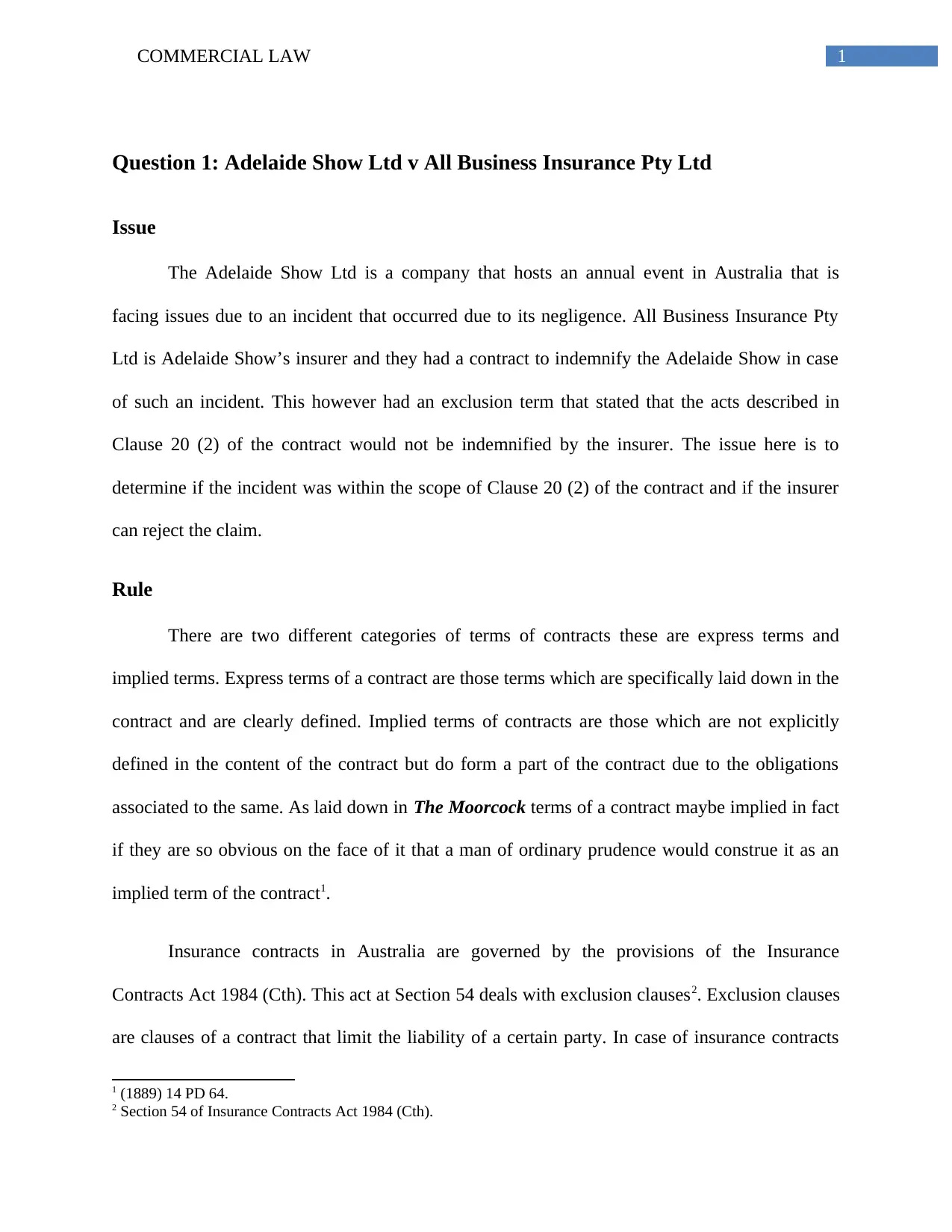
1COMMERCIAL LAW
Question 1: Adelaide Show Ltd v All Business Insurance Pty Ltd
Issue
The Adelaide Show Ltd is a company that hosts an annual event in Australia that is
facing issues due to an incident that occurred due to its negligence. All Business Insurance Pty
Ltd is Adelaide Show’s insurer and they had a contract to indemnify the Adelaide Show in case
of such an incident. This however had an exclusion term that stated that the acts described in
Clause 20 (2) of the contract would not be indemnified by the insurer. The issue here is to
determine if the incident was within the scope of Clause 20 (2) of the contract and if the insurer
can reject the claim.
Rule
There are two different categories of terms of contracts these are express terms and
implied terms. Express terms of a contract are those terms which are specifically laid down in the
contract and are clearly defined. Implied terms of contracts are those which are not explicitly
defined in the content of the contract but do form a part of the contract due to the obligations
associated to the same. As laid down in The Moorcock terms of a contract maybe implied in fact
if they are so obvious on the face of it that a man of ordinary prudence would construe it as an
implied term of the contract1.
Insurance contracts in Australia are governed by the provisions of the Insurance
Contracts Act 1984 (Cth). This act at Section 54 deals with exclusion clauses2. Exclusion clauses
are clauses of a contract that limit the liability of a certain party. In case of insurance contracts
1 (1889) 14 PD 64.
2 Section 54 of Insurance Contracts Act 1984 (Cth).
Question 1: Adelaide Show Ltd v All Business Insurance Pty Ltd
Issue
The Adelaide Show Ltd is a company that hosts an annual event in Australia that is
facing issues due to an incident that occurred due to its negligence. All Business Insurance Pty
Ltd is Adelaide Show’s insurer and they had a contract to indemnify the Adelaide Show in case
of such an incident. This however had an exclusion term that stated that the acts described in
Clause 20 (2) of the contract would not be indemnified by the insurer. The issue here is to
determine if the incident was within the scope of Clause 20 (2) of the contract and if the insurer
can reject the claim.
Rule
There are two different categories of terms of contracts these are express terms and
implied terms. Express terms of a contract are those terms which are specifically laid down in the
contract and are clearly defined. Implied terms of contracts are those which are not explicitly
defined in the content of the contract but do form a part of the contract due to the obligations
associated to the same. As laid down in The Moorcock terms of a contract maybe implied in fact
if they are so obvious on the face of it that a man of ordinary prudence would construe it as an
implied term of the contract1.
Insurance contracts in Australia are governed by the provisions of the Insurance
Contracts Act 1984 (Cth). This act at Section 54 deals with exclusion clauses2. Exclusion clauses
are clauses of a contract that limit the liability of a certain party. In case of insurance contracts
1 (1889) 14 PD 64.
2 Section 54 of Insurance Contracts Act 1984 (Cth).
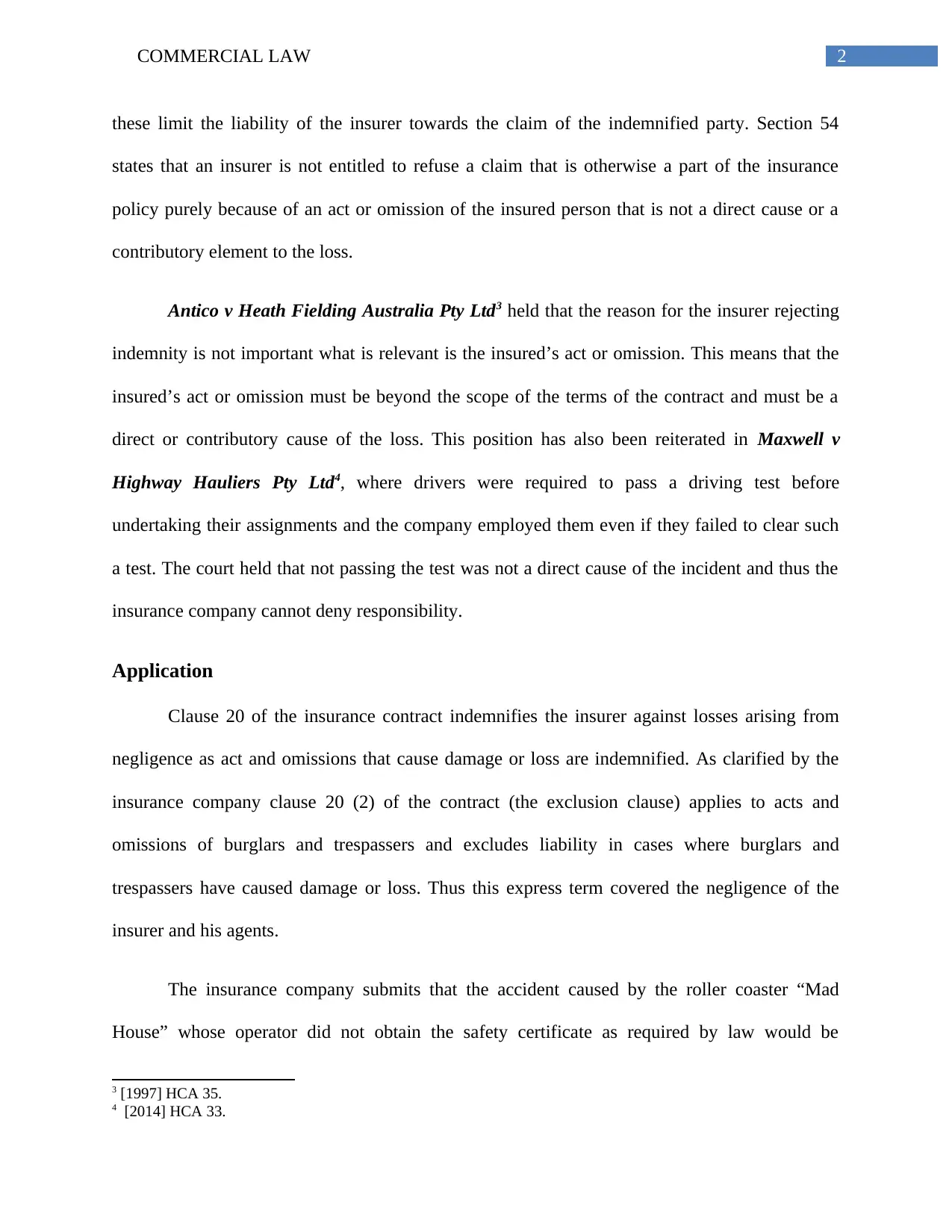
2COMMERCIAL LAW
these limit the liability of the insurer towards the claim of the indemnified party. Section 54
states that an insurer is not entitled to refuse a claim that is otherwise a part of the insurance
policy purely because of an act or omission of the insured person that is not a direct cause or a
contributory element to the loss.
Antico v Heath Fielding Australia Pty Ltd3 held that the reason for the insurer rejecting
indemnity is not important what is relevant is the insured’s act or omission. This means that the
insured’s act or omission must be beyond the scope of the terms of the contract and must be a
direct or contributory cause of the loss. This position has also been reiterated in Maxwell v
Highway Hauliers Pty Ltd4, where drivers were required to pass a driving test before
undertaking their assignments and the company employed them even if they failed to clear such
a test. The court held that not passing the test was not a direct cause of the incident and thus the
insurance company cannot deny responsibility.
Application
Clause 20 of the insurance contract indemnifies the insurer against losses arising from
negligence as act and omissions that cause damage or loss are indemnified. As clarified by the
insurance company clause 20 (2) of the contract (the exclusion clause) applies to acts and
omissions of burglars and trespassers and excludes liability in cases where burglars and
trespassers have caused damage or loss. Thus this express term covered the negligence of the
insurer and his agents.
The insurance company submits that the accident caused by the roller coaster “Mad
House” whose operator did not obtain the safety certificate as required by law would be
3 [1997] HCA 35.
4 [2014] HCA 33.
these limit the liability of the insurer towards the claim of the indemnified party. Section 54
states that an insurer is not entitled to refuse a claim that is otherwise a part of the insurance
policy purely because of an act or omission of the insured person that is not a direct cause or a
contributory element to the loss.
Antico v Heath Fielding Australia Pty Ltd3 held that the reason for the insurer rejecting
indemnity is not important what is relevant is the insured’s act or omission. This means that the
insured’s act or omission must be beyond the scope of the terms of the contract and must be a
direct or contributory cause of the loss. This position has also been reiterated in Maxwell v
Highway Hauliers Pty Ltd4, where drivers were required to pass a driving test before
undertaking their assignments and the company employed them even if they failed to clear such
a test. The court held that not passing the test was not a direct cause of the incident and thus the
insurance company cannot deny responsibility.
Application
Clause 20 of the insurance contract indemnifies the insurer against losses arising from
negligence as act and omissions that cause damage or loss are indemnified. As clarified by the
insurance company clause 20 (2) of the contract (the exclusion clause) applies to acts and
omissions of burglars and trespassers and excludes liability in cases where burglars and
trespassers have caused damage or loss. Thus this express term covered the negligence of the
insurer and his agents.
The insurance company submits that the accident caused by the roller coaster “Mad
House” whose operator did not obtain the safety certificate as required by law would be
3 [1997] HCA 35.
4 [2014] HCA 33.
⊘ This is a preview!⊘
Do you want full access?
Subscribe today to unlock all pages.

Trusted by 1+ million students worldwide
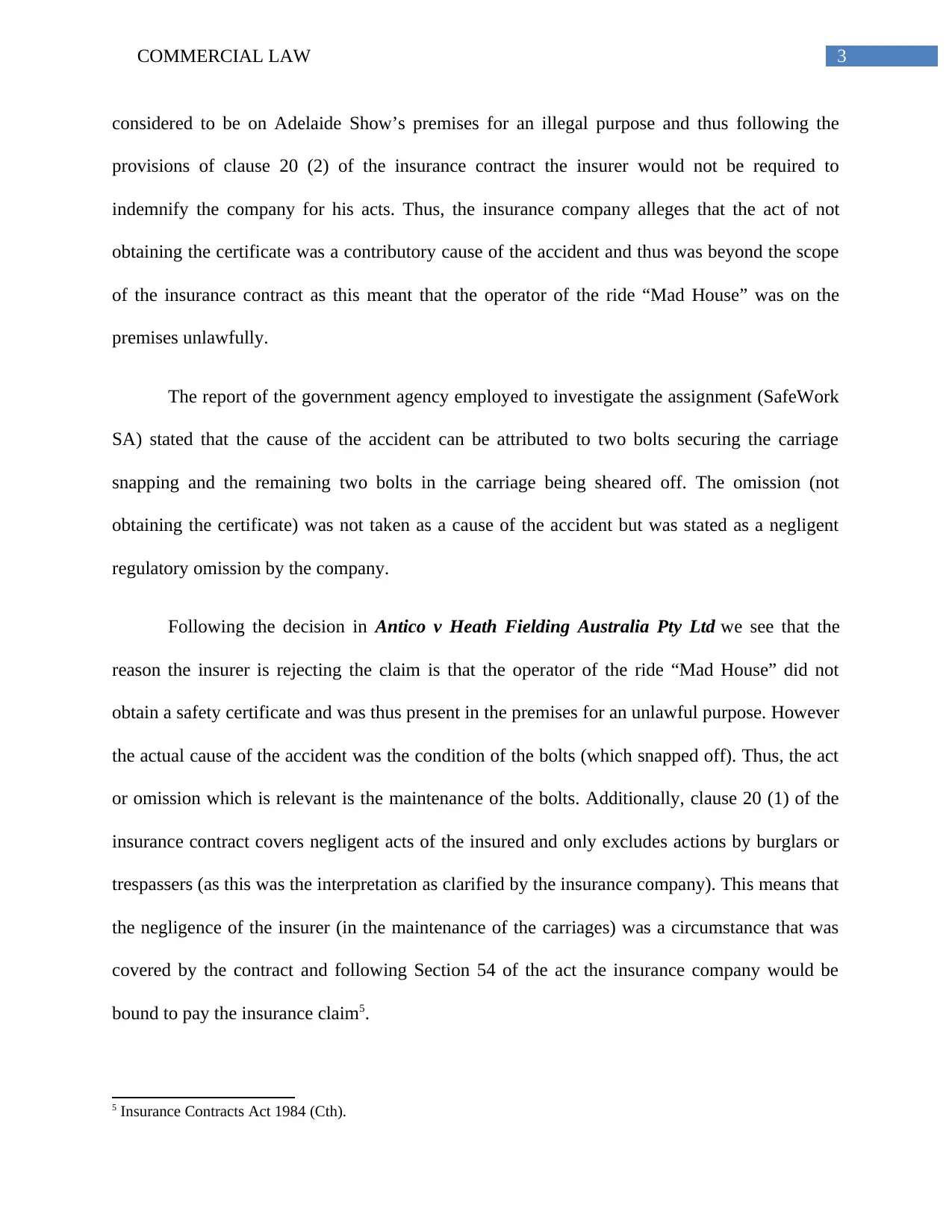
3COMMERCIAL LAW
considered to be on Adelaide Show’s premises for an illegal purpose and thus following the
provisions of clause 20 (2) of the insurance contract the insurer would not be required to
indemnify the company for his acts. Thus, the insurance company alleges that the act of not
obtaining the certificate was a contributory cause of the accident and thus was beyond the scope
of the insurance contract as this meant that the operator of the ride “Mad House” was on the
premises unlawfully.
The report of the government agency employed to investigate the assignment (SafeWork
SA) stated that the cause of the accident can be attributed to two bolts securing the carriage
snapping and the remaining two bolts in the carriage being sheared off. The omission (not
obtaining the certificate) was not taken as a cause of the accident but was stated as a negligent
regulatory omission by the company.
Following the decision in Antico v Heath Fielding Australia Pty Ltd we see that the
reason the insurer is rejecting the claim is that the operator of the ride “Mad House” did not
obtain a safety certificate and was thus present in the premises for an unlawful purpose. However
the actual cause of the accident was the condition of the bolts (which snapped off). Thus, the act
or omission which is relevant is the maintenance of the bolts. Additionally, clause 20 (1) of the
insurance contract covers negligent acts of the insured and only excludes actions by burglars or
trespassers (as this was the interpretation as clarified by the insurance company). This means that
the negligence of the insurer (in the maintenance of the carriages) was a circumstance that was
covered by the contract and following Section 54 of the act the insurance company would be
bound to pay the insurance claim5.
5 Insurance Contracts Act 1984 (Cth).
considered to be on Adelaide Show’s premises for an illegal purpose and thus following the
provisions of clause 20 (2) of the insurance contract the insurer would not be required to
indemnify the company for his acts. Thus, the insurance company alleges that the act of not
obtaining the certificate was a contributory cause of the accident and thus was beyond the scope
of the insurance contract as this meant that the operator of the ride “Mad House” was on the
premises unlawfully.
The report of the government agency employed to investigate the assignment (SafeWork
SA) stated that the cause of the accident can be attributed to two bolts securing the carriage
snapping and the remaining two bolts in the carriage being sheared off. The omission (not
obtaining the certificate) was not taken as a cause of the accident but was stated as a negligent
regulatory omission by the company.
Following the decision in Antico v Heath Fielding Australia Pty Ltd we see that the
reason the insurer is rejecting the claim is that the operator of the ride “Mad House” did not
obtain a safety certificate and was thus present in the premises for an unlawful purpose. However
the actual cause of the accident was the condition of the bolts (which snapped off). Thus, the act
or omission which is relevant is the maintenance of the bolts. Additionally, clause 20 (1) of the
insurance contract covers negligent acts of the insured and only excludes actions by burglars or
trespassers (as this was the interpretation as clarified by the insurance company). This means that
the negligence of the insurer (in the maintenance of the carriages) was a circumstance that was
covered by the contract and following Section 54 of the act the insurance company would be
bound to pay the insurance claim5.
5 Insurance Contracts Act 1984 (Cth).
Paraphrase This Document
Need a fresh take? Get an instant paraphrase of this document with our AI Paraphraser
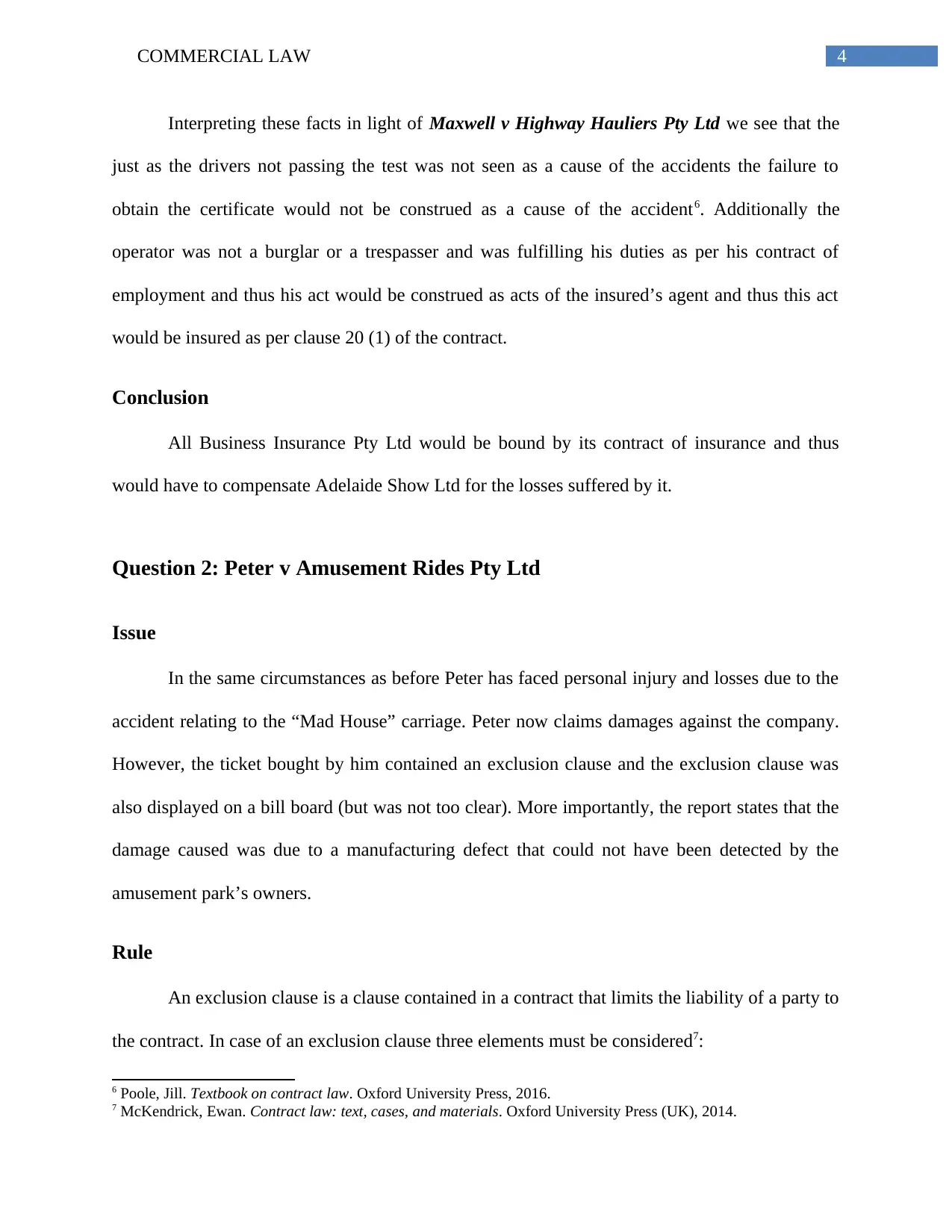
4COMMERCIAL LAW
Interpreting these facts in light of Maxwell v Highway Hauliers Pty Ltd we see that the
just as the drivers not passing the test was not seen as a cause of the accidents the failure to
obtain the certificate would not be construed as a cause of the accident6. Additionally the
operator was not a burglar or a trespasser and was fulfilling his duties as per his contract of
employment and thus his act would be construed as acts of the insured’s agent and thus this act
would be insured as per clause 20 (1) of the contract.
Conclusion
All Business Insurance Pty Ltd would be bound by its contract of insurance and thus
would have to compensate Adelaide Show Ltd for the losses suffered by it.
Question 2: Peter v Amusement Rides Pty Ltd
Issue
In the same circumstances as before Peter has faced personal injury and losses due to the
accident relating to the “Mad House” carriage. Peter now claims damages against the company.
However, the ticket bought by him contained an exclusion clause and the exclusion clause was
also displayed on a bill board (but was not too clear). More importantly, the report states that the
damage caused was due to a manufacturing defect that could not have been detected by the
amusement park’s owners.
Rule
An exclusion clause is a clause contained in a contract that limits the liability of a party to
the contract. In case of an exclusion clause three elements must be considered7:
6 Poole, Jill. Textbook on contract law. Oxford University Press, 2016.
7 McKendrick, Ewan. Contract law: text, cases, and materials. Oxford University Press (UK), 2014.
Interpreting these facts in light of Maxwell v Highway Hauliers Pty Ltd we see that the
just as the drivers not passing the test was not seen as a cause of the accidents the failure to
obtain the certificate would not be construed as a cause of the accident6. Additionally the
operator was not a burglar or a trespasser and was fulfilling his duties as per his contract of
employment and thus his act would be construed as acts of the insured’s agent and thus this act
would be insured as per clause 20 (1) of the contract.
Conclusion
All Business Insurance Pty Ltd would be bound by its contract of insurance and thus
would have to compensate Adelaide Show Ltd for the losses suffered by it.
Question 2: Peter v Amusement Rides Pty Ltd
Issue
In the same circumstances as before Peter has faced personal injury and losses due to the
accident relating to the “Mad House” carriage. Peter now claims damages against the company.
However, the ticket bought by him contained an exclusion clause and the exclusion clause was
also displayed on a bill board (but was not too clear). More importantly, the report states that the
damage caused was due to a manufacturing defect that could not have been detected by the
amusement park’s owners.
Rule
An exclusion clause is a clause contained in a contract that limits the liability of a party to
the contract. In case of an exclusion clause three elements must be considered7:
6 Poole, Jill. Textbook on contract law. Oxford University Press, 2016.
7 McKendrick, Ewan. Contract law: text, cases, and materials. Oxford University Press (UK), 2014.

5COMMERCIAL LAW
Incorporation: The term must be incorporated into the contract.
Interpretation: The term must be interpreted in the right way (relating to the intent of the
term).
Unfair terms: It must not be in contravention of the Unfair Contact Terms Act, 1977.
In Thompson v LMS Railway8 an excursion ticket containing express conditions was
sold to a person who cannot read. The court held that since it could be presumed that such a
ticket would contain express conditions the exclusion clause would be deemed to be incorporated
into the contract.
The judgment in McCutcheon v MacBrayne9 stated that when an exclusion clause was
stated at the ticket booking counter of a ferry service which was often not read by the patrons and
in a “risk note” which was seldom signed by the patrons the exclusion clause would not be
deemed to have been incorporated into the terms of the contract. This was due to the lack of
consistency on the procedure.
Volenti non fit iniuria is a common law principle which states that liability cannot be
attributed in a case where the person subject to the loss or damage voluntarily undertook the risk
of such a loss or damage10. Here the claimant must fully be aware of the extent of the risk he was
undertaking and the claimant explicitly or in an implied manner bequeaths his right to claim
damages. This principle has been further reiterated in cases such as Tomlinson v Congleton
Borough Council11 and Morris v Murray12.
8 [1930] 1 KB 41.
9 [1964] 1 WLR 125.
10 Descheemaeker, Eric, and Helen Scott, eds. Iniuria and the Common Law. Bloomsbury Publishing, 2013.
11 [2003] UKHL 47.
12 [1990] 3 All ER 801.
Incorporation: The term must be incorporated into the contract.
Interpretation: The term must be interpreted in the right way (relating to the intent of the
term).
Unfair terms: It must not be in contravention of the Unfair Contact Terms Act, 1977.
In Thompson v LMS Railway8 an excursion ticket containing express conditions was
sold to a person who cannot read. The court held that since it could be presumed that such a
ticket would contain express conditions the exclusion clause would be deemed to be incorporated
into the contract.
The judgment in McCutcheon v MacBrayne9 stated that when an exclusion clause was
stated at the ticket booking counter of a ferry service which was often not read by the patrons and
in a “risk note” which was seldom signed by the patrons the exclusion clause would not be
deemed to have been incorporated into the terms of the contract. This was due to the lack of
consistency on the procedure.
Volenti non fit iniuria is a common law principle which states that liability cannot be
attributed in a case where the person subject to the loss or damage voluntarily undertook the risk
of such a loss or damage10. Here the claimant must fully be aware of the extent of the risk he was
undertaking and the claimant explicitly or in an implied manner bequeaths his right to claim
damages. This principle has been further reiterated in cases such as Tomlinson v Congleton
Borough Council11 and Morris v Murray12.
8 [1930] 1 KB 41.
9 [1964] 1 WLR 125.
10 Descheemaeker, Eric, and Helen Scott, eds. Iniuria and the Common Law. Bloomsbury Publishing, 2013.
11 [2003] UKHL 47.
12 [1990] 3 All ER 801.
⊘ This is a preview!⊘
Do you want full access?
Subscribe today to unlock all pages.

Trusted by 1+ million students worldwide
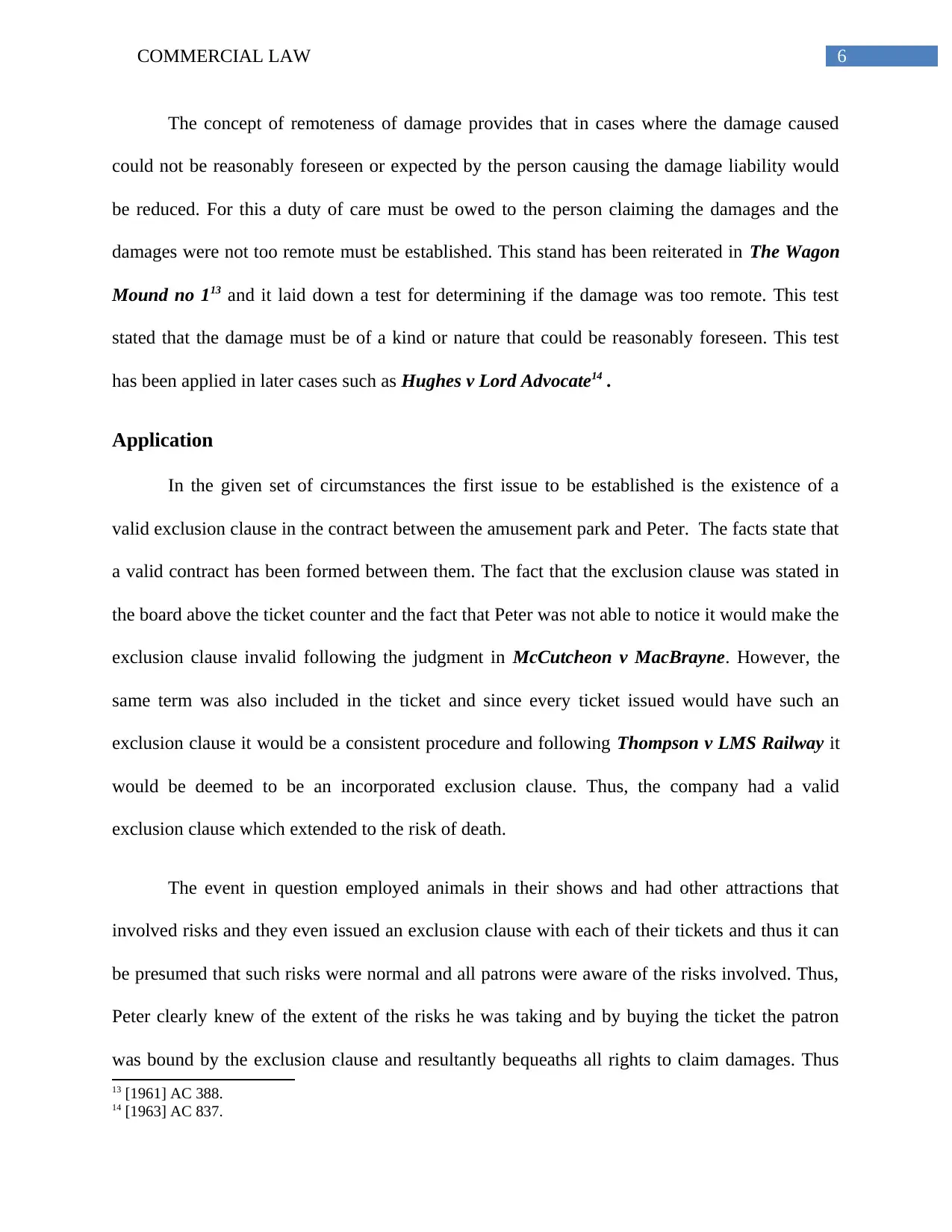
6COMMERCIAL LAW
The concept of remoteness of damage provides that in cases where the damage caused
could not be reasonably foreseen or expected by the person causing the damage liability would
be reduced. For this a duty of care must be owed to the person claiming the damages and the
damages were not too remote must be established. This stand has been reiterated in The Wagon
Mound no 113 and it laid down a test for determining if the damage was too remote. This test
stated that the damage must be of a kind or nature that could be reasonably foreseen. This test
has been applied in later cases such as Hughes v Lord Advocate14 .
Application
In the given set of circumstances the first issue to be established is the existence of a
valid exclusion clause in the contract between the amusement park and Peter. The facts state that
a valid contract has been formed between them. The fact that the exclusion clause was stated in
the board above the ticket counter and the fact that Peter was not able to notice it would make the
exclusion clause invalid following the judgment in McCutcheon v MacBrayne. However, the
same term was also included in the ticket and since every ticket issued would have such an
exclusion clause it would be a consistent procedure and following Thompson v LMS Railway it
would be deemed to be an incorporated exclusion clause. Thus, the company had a valid
exclusion clause which extended to the risk of death.
The event in question employed animals in their shows and had other attractions that
involved risks and they even issued an exclusion clause with each of their tickets and thus it can
be presumed that such risks were normal and all patrons were aware of the risks involved. Thus,
Peter clearly knew of the extent of the risks he was taking and by buying the ticket the patron
was bound by the exclusion clause and resultantly bequeaths all rights to claim damages. Thus
13 [1961] AC 388.
14 [1963] AC 837.
The concept of remoteness of damage provides that in cases where the damage caused
could not be reasonably foreseen or expected by the person causing the damage liability would
be reduced. For this a duty of care must be owed to the person claiming the damages and the
damages were not too remote must be established. This stand has been reiterated in The Wagon
Mound no 113 and it laid down a test for determining if the damage was too remote. This test
stated that the damage must be of a kind or nature that could be reasonably foreseen. This test
has been applied in later cases such as Hughes v Lord Advocate14 .
Application
In the given set of circumstances the first issue to be established is the existence of a
valid exclusion clause in the contract between the amusement park and Peter. The facts state that
a valid contract has been formed between them. The fact that the exclusion clause was stated in
the board above the ticket counter and the fact that Peter was not able to notice it would make the
exclusion clause invalid following the judgment in McCutcheon v MacBrayne. However, the
same term was also included in the ticket and since every ticket issued would have such an
exclusion clause it would be a consistent procedure and following Thompson v LMS Railway it
would be deemed to be an incorporated exclusion clause. Thus, the company had a valid
exclusion clause which extended to the risk of death.
The event in question employed animals in their shows and had other attractions that
involved risks and they even issued an exclusion clause with each of their tickets and thus it can
be presumed that such risks were normal and all patrons were aware of the risks involved. Thus,
Peter clearly knew of the extent of the risks he was taking and by buying the ticket the patron
was bound by the exclusion clause and resultantly bequeaths all rights to claim damages. Thus
13 [1961] AC 388.
14 [1963] AC 837.
Paraphrase This Document
Need a fresh take? Get an instant paraphrase of this document with our AI Paraphraser

7COMMERCIAL LAW
following the judgment in Tomlinson v Congleton Borough Council and applying the doctrine
of Volenti non fit iniuria it can be inferred that the risk taken was a voluntary risk and thus the
company would not be liable for the damages that Peter suffered.
The accident occurred due to the bolts fastening the carriage to the ride being defective.
The investigating agency SafeWork SA in its report stated that the accident happened due to a
latent manufacturing defect in the bolts and this defect could not be detected by the company
before the actual accident. Thus, applying the test laid down in The Wagon Mound no 1 it can
be inferred that the damage was in no way foreseeable and was not of a nature that could be
reasonably expected to occur15. The doctrine of remoteness of damage would be applicable in
this case and thus it would be construed as too remote to be reasonably foreseen by a man of
ordinary prudence16. In this case the company would not be liable to compensate for damage that
is of such a remote nature.
Conclusion
To conclude Amusement Rides Pty Ltd would not be liable to compensate Peter for the
loss suffered by him. This is due to the existence of the exclusion clause which Peter is bound
by, the doctrine of Volenti Non fit injuria and the remoteness of damage which would exonerate
the company from any liability. Thus Peter would not be able to recover damages from the
company.
15 Knapp, Charles L., Nathan M. Crystal, and Harry G. Prince. Problems in Contract Law: cases and materials.
Wolters Kluwer Law & Business, 2016.
16 Hunter, Howard. "Modern Law of Contracts." (2017).
following the judgment in Tomlinson v Congleton Borough Council and applying the doctrine
of Volenti non fit iniuria it can be inferred that the risk taken was a voluntary risk and thus the
company would not be liable for the damages that Peter suffered.
The accident occurred due to the bolts fastening the carriage to the ride being defective.
The investigating agency SafeWork SA in its report stated that the accident happened due to a
latent manufacturing defect in the bolts and this defect could not be detected by the company
before the actual accident. Thus, applying the test laid down in The Wagon Mound no 1 it can
be inferred that the damage was in no way foreseeable and was not of a nature that could be
reasonably expected to occur15. The doctrine of remoteness of damage would be applicable in
this case and thus it would be construed as too remote to be reasonably foreseen by a man of
ordinary prudence16. In this case the company would not be liable to compensate for damage that
is of such a remote nature.
Conclusion
To conclude Amusement Rides Pty Ltd would not be liable to compensate Peter for the
loss suffered by him. This is due to the existence of the exclusion clause which Peter is bound
by, the doctrine of Volenti Non fit injuria and the remoteness of damage which would exonerate
the company from any liability. Thus Peter would not be able to recover damages from the
company.
15 Knapp, Charles L., Nathan M. Crystal, and Harry G. Prince. Problems in Contract Law: cases and materials.
Wolters Kluwer Law & Business, 2016.
16 Hunter, Howard. "Modern Law of Contracts." (2017).
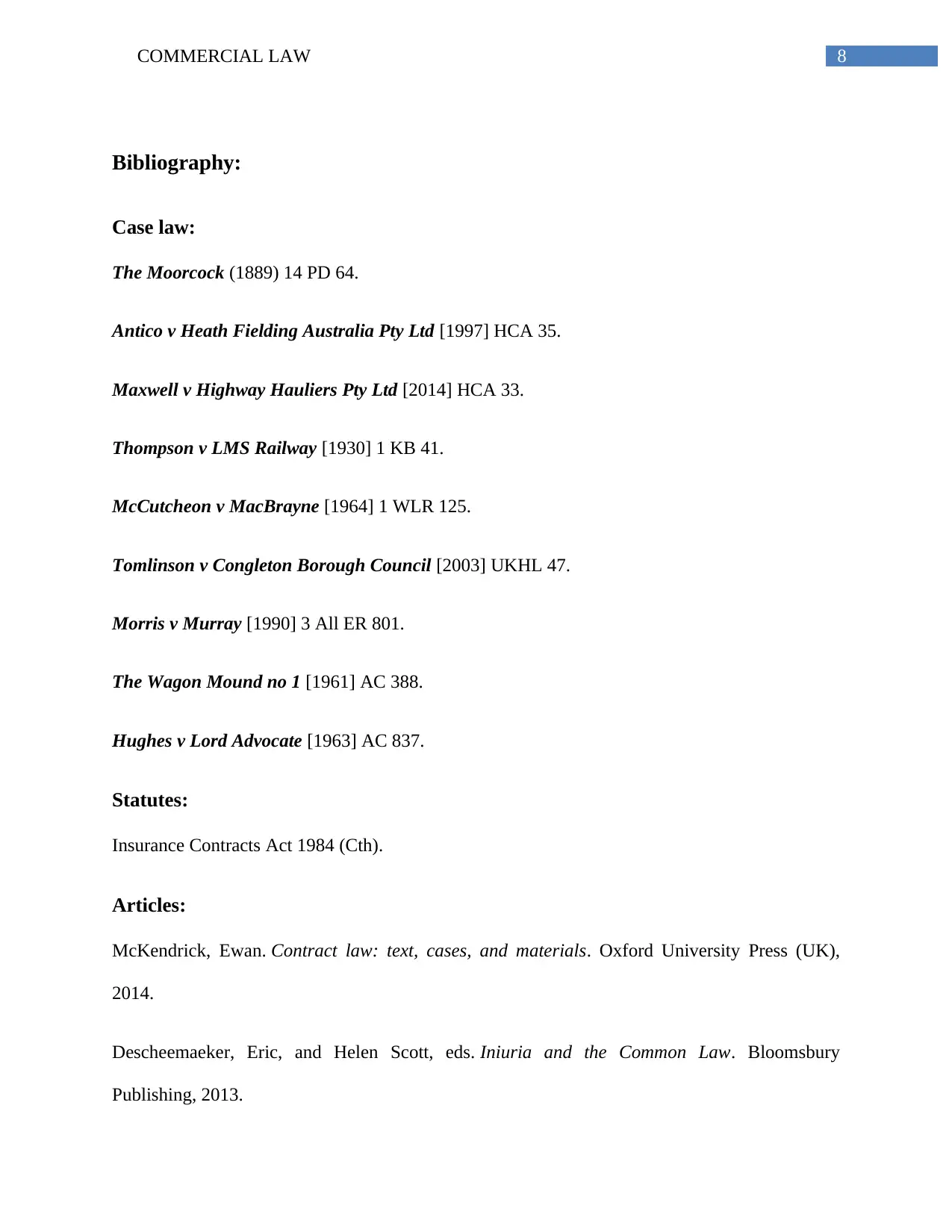
8COMMERCIAL LAW
Bibliography:
Case law:
The Moorcock (1889) 14 PD 64.
Antico v Heath Fielding Australia Pty Ltd [1997] HCA 35.
Maxwell v Highway Hauliers Pty Ltd [2014] HCA 33.
Thompson v LMS Railway [1930] 1 KB 41.
McCutcheon v MacBrayne [1964] 1 WLR 125.
Tomlinson v Congleton Borough Council [2003] UKHL 47.
Morris v Murray [1990] 3 All ER 801.
The Wagon Mound no 1 [1961] AC 388.
Hughes v Lord Advocate [1963] AC 837.
Statutes:
Insurance Contracts Act 1984 (Cth).
Articles:
McKendrick, Ewan. Contract law: text, cases, and materials. Oxford University Press (UK),
2014.
Descheemaeker, Eric, and Helen Scott, eds. Iniuria and the Common Law. Bloomsbury
Publishing, 2013.
Bibliography:
Case law:
The Moorcock (1889) 14 PD 64.
Antico v Heath Fielding Australia Pty Ltd [1997] HCA 35.
Maxwell v Highway Hauliers Pty Ltd [2014] HCA 33.
Thompson v LMS Railway [1930] 1 KB 41.
McCutcheon v MacBrayne [1964] 1 WLR 125.
Tomlinson v Congleton Borough Council [2003] UKHL 47.
Morris v Murray [1990] 3 All ER 801.
The Wagon Mound no 1 [1961] AC 388.
Hughes v Lord Advocate [1963] AC 837.
Statutes:
Insurance Contracts Act 1984 (Cth).
Articles:
McKendrick, Ewan. Contract law: text, cases, and materials. Oxford University Press (UK),
2014.
Descheemaeker, Eric, and Helen Scott, eds. Iniuria and the Common Law. Bloomsbury
Publishing, 2013.
⊘ This is a preview!⊘
Do you want full access?
Subscribe today to unlock all pages.

Trusted by 1+ million students worldwide

9COMMERCIAL LAW
Knapp, Charles L., Nathan M. Crystal, and Harry G. Prince. Problems in Contract Law: cases
and materials. Wolters Kluwer Law & Business, 2016.
Poole, Jill. Textbook on contract law. Oxford University Press, 2016.
Hunter, Howard. "Modern Law of Contracts." (2017).
Knapp, Charles L., Nathan M. Crystal, and Harry G. Prince. Problems in Contract Law: cases
and materials. Wolters Kluwer Law & Business, 2016.
Poole, Jill. Textbook on contract law. Oxford University Press, 2016.
Hunter, Howard. "Modern Law of Contracts." (2017).
1 out of 10
Related Documents
Your All-in-One AI-Powered Toolkit for Academic Success.
+13062052269
info@desklib.com
Available 24*7 on WhatsApp / Email
![[object Object]](/_next/static/media/star-bottom.7253800d.svg)
Unlock your academic potential
Copyright © 2020–2025 A2Z Services. All Rights Reserved. Developed and managed by ZUCOL.





